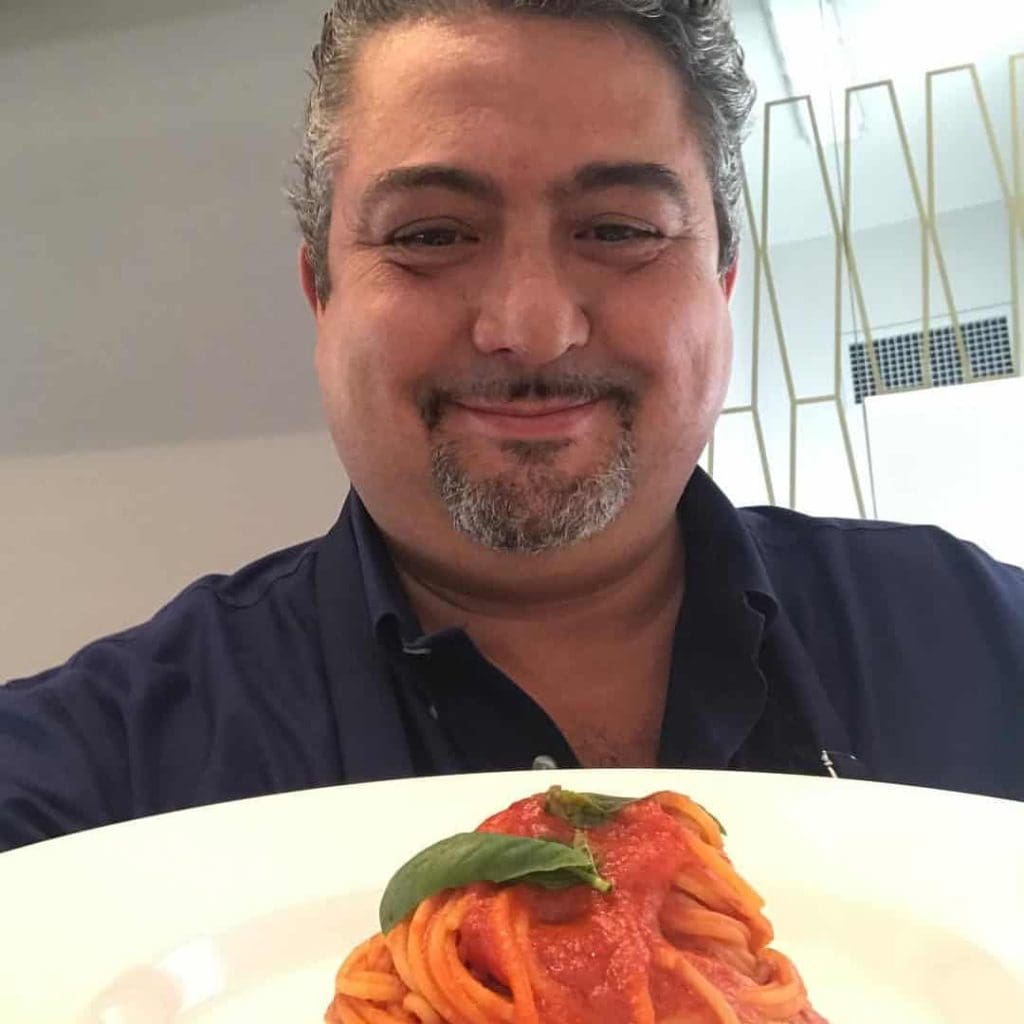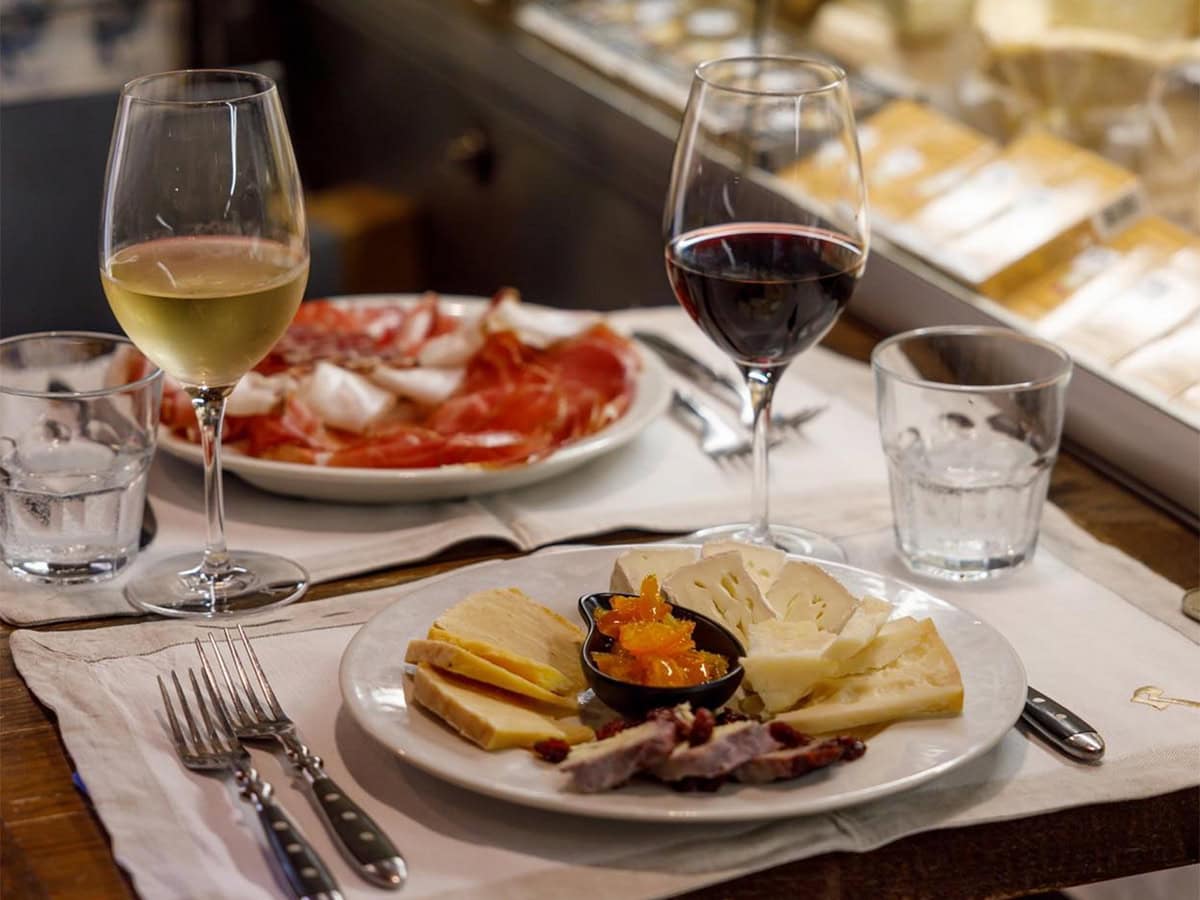A well-known producer of Gragnano pasta (with the brands Di Martino and Pastificio dei Campi), Giuseppe Di Martino is also a restaurateur: his pasta bars are a kind of concept restaurant entirely dedicated to the most iconic Italian product, offered in dozens of variations and interpretations. Simple, immediate, and delicious recipes made with high-quality raw ingredients, available for purchase, to be enjoyed on-site, or ready for takeaway. The New York location is named Devozione: nothing less than the most classic and beloved dish, spaghetti with tomato sauce, presented with the imprint of another pasta master, Peppe Guida. But such simplicity demands impeccable, authentic, high-quality ingredients: pasta, oil, tomatoes, and cheese. Precisely the products targeted by the tariffs announced by Trump, which could also boost the Italian sounding phenomenon.

So in the end, it looks like the tariffs will be imposed… how do you feel about it?
I’d sum it up like this: tensions, concerns, problems. Our generation has been quite unlucky, to say the least. There’s no respite: in the last eight years, we’ve faced everything, and there’s no way out.
Covid, wars, rising raw material costs… and now tariffs.
And anything that disrupts the normal balance of supply and demand is never good news.
What will you do?
First, we need to understand exactly how the tariff regulations will be structured. The issue of reciprocity, which is being discussed, has to be assessed on a case-by-case basis. For example, I read yesterday that in Italy, the tariff on American cheeses is between 30-36% (Parmigiano Reggiano will reach 35% when old and new tariffs are combined, editor’s note). However, I don’t believe there are tariffs on American pasta, whereas Italian pasta already has tariffs in the US for each individual company.
For each individual company?
Yes, for the past 30 years or so, each company has had its own customised tariff due to anti-dumping regulations. On average, it's around 12-15%, but now we need to understand if new tariffs will be added to these.
Are you worried as a producer?
Yes and no: for a premium product like Gragnano pasta, these fluctuations generally have a lower impact on demand because the customer buying a top-tier product is already part of a market elite that values its quality. They choose it for its excellence, not for its price. Of course, there will be price adjustments because importers will have to pass on the increased costs to customers, but the price elasticity for high-end products is lower than for the rest of the range.
Is Italian pasta always considered a high-end product?
Italian-made pasta accounts for only 5% of the pasta consumed in the United States. I believe, and hope, that those who choose it will continue to do so.
Are you speaking from direct experience?
Coming from a market that has already faced high inflationary pressures and had to deal with rising prices, I can say that so far, there haven't been any major shocks. There had been a reduction in energy and raw material costs after the significant increases in 2022 due to the war and its consequences. Prices were stabilising, but now they will likely rise again. The truth is, no one knows what will happen at this point. The situation isn’t yet clear or defined, and we don’t know when or how these tariffs will be implemented. There is only one certainty.
Which is?
I’m not happy about these tariffs; they don’t benefit anyone, especially not the consumer. But the real market impact will be felt in a couple of months, if the tariffs remain in place.
Why a couple of months?
Because, on average, the United States holds about 60 days' worth of stock. Keeping larger quantities means significant financial exposure, combined with uncertainty about what will happen. Once the stock runs out, the real impact of the tariffs will be felt in consumer spending, as the 20% increase will have to be immediately passed on to the market.
How is this phase being experienced in the US?
The most widespread feeling is one of waiting. No one fully understands these tariffs—some think it’s easy to shift production, others believe the cost increases will be absorbed by foreign countries. The US remains divided between those who voted for Trump and those who didn’t. But some effects are already visible—some people have lost their jobs due to Doge.
So far, we've heard from Di Martino the producer. But there’s also Di Martino the restaurateur. Your New York pasta bar is based on simple dishes made with Italian ingredients. What do you expect?
As a restaurateur, I expect an increase in raw material costs, but I can’t make compromises. If I make cacio e pepe with Pecorino Romano DOP, I have to use Pecorino Romano DOP. If its price goes up, we’ll have to adjust our prices too—there’s no way around it, we can’t just use another cheese.
Could this affect the market?
Italian food has always been seen as a product with a good quality-price ratio. Those who use American raw materials will have an advantage in this scenario. The gap between those offering an authentic, high-quality product and those who don’t will widen. I hope a deal is reached because we’ve already taken heavy blows from all sides, and tariffs were the last thing we needed.
So a restaurateur who doesn’t use imported products will be at an advantage?
I believe every restaurateur will be affected negatively in some way because all products are subject to inflation, not just food. Even something like a piece of kitchen equipment can be affected.
So, are you more concerned as a restaurateur than as a producer?
I'm concerned in general, though less so as a producer. But uncertainty is the real issue. Those who have to decide whether to put an imported product on their shelves or menu are waiting to see what happens. This creates market distortions and disruptions that won’t be easy to recover from—because once you decide to exclude a product, bringing it back won’t be simple, especially for those of us who are forced to operate in a niche market.
Why are you forced into the niche market?
Because our costs are high: welfare, regulations, food safety standards, the inefficiency of our public administration—these are all burdens. But our strength lies in the quality-price ratio, which has always been unbeatable. In manufacturing quality, at all levels—we have excellence, taste, and creativity. We’re not the world’s factory, but we are the world’s factory of good things. Our key advantage is the gap between entry-level and premium products.
In conclusion?
I love the US and its entrepreneurial spirit, I love what it has represented over the past 80 years, and I’m certain we’ll find a solution with our American friends.
This preserves the full detail and flow of the original while ensuring fluent, natural UK English. Let me know if you’d like any refinements!


 The 14 Rosso di Montalcino wines with the best quality-price ratio
The 14 Rosso di Montalcino wines with the best quality-price ratio One of Lazio’s best trattorias opens a bakery and a seafood restaurant: here are Buccia’s new projects
One of Lazio’s best trattorias opens a bakery and a seafood restaurant: here are Buccia’s new projects Where to drink in Rome: the best Wine Bars with food selected by Gambero Rosso
Where to drink in Rome: the best Wine Bars with food selected by Gambero Rosso The Consorzio dei Vignaioli del Lazio is born. This is how artisan producers challenge the agro-industrial model
The Consorzio dei Vignaioli del Lazio is born. This is how artisan producers challenge the agro-industrial model Where to eat gelato in Milan: the best spots
Where to eat gelato in Milan: the best spots






